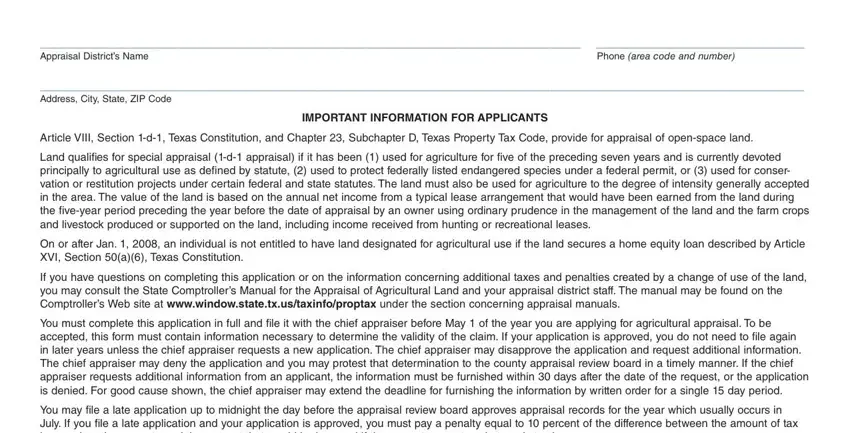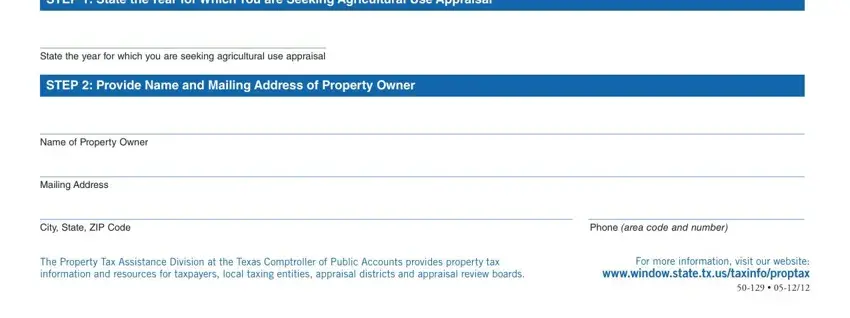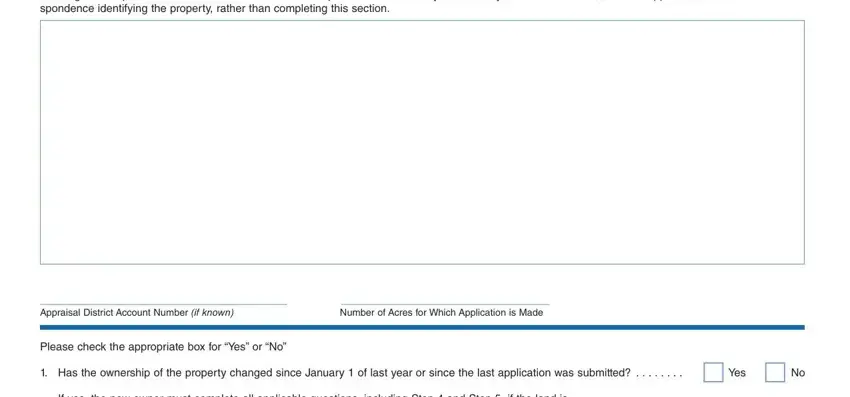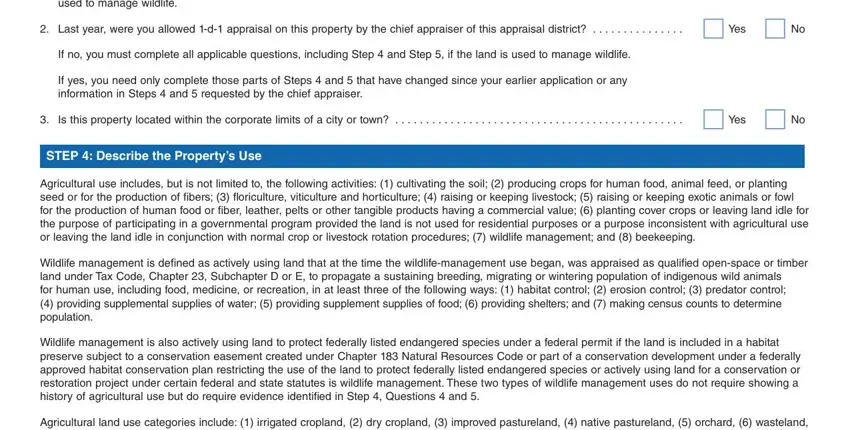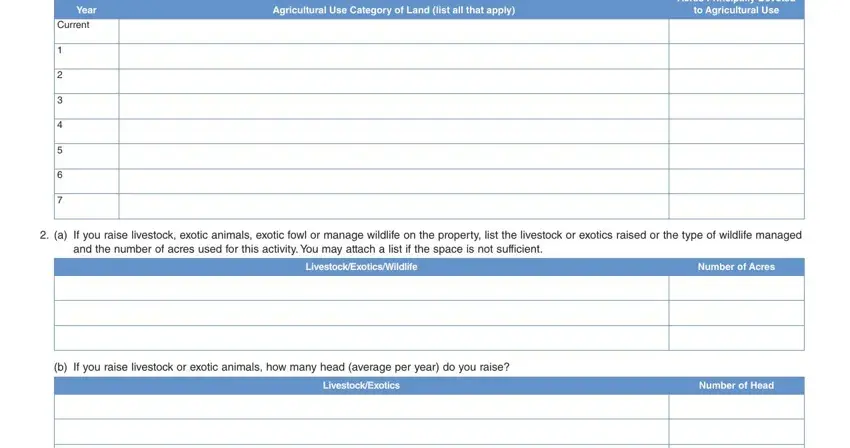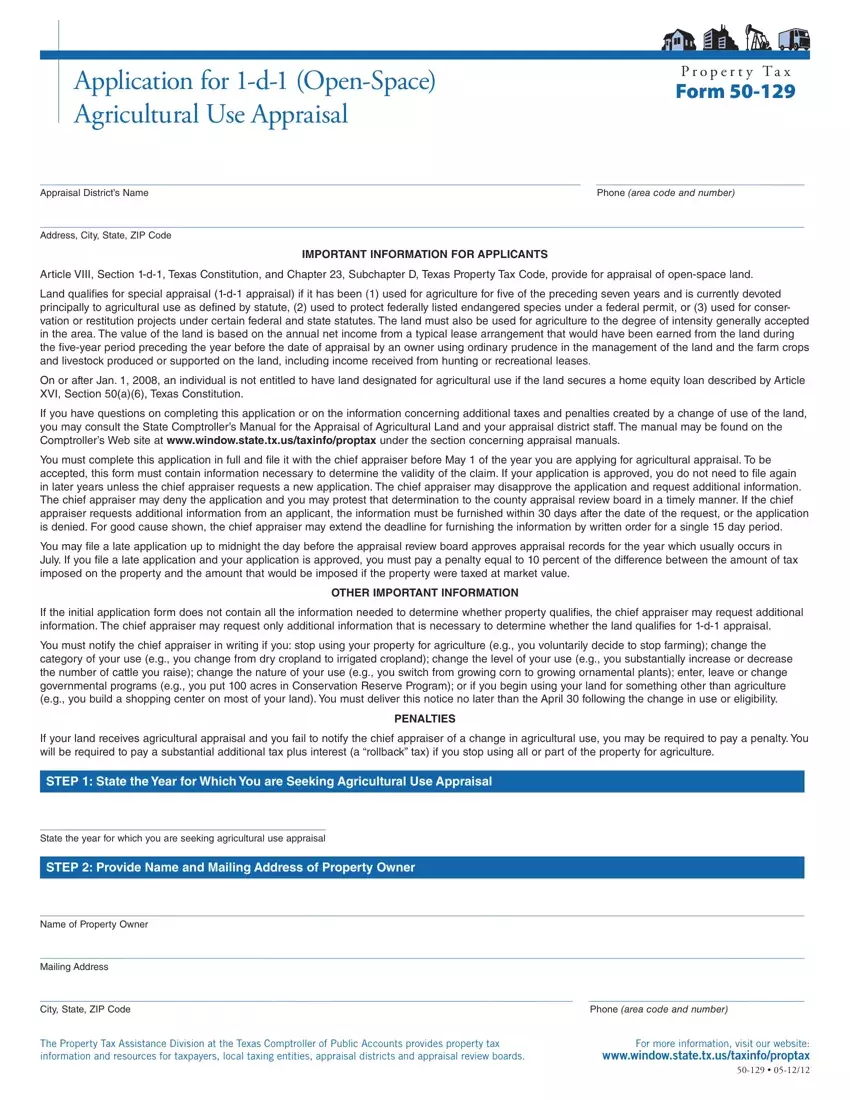______________________________________________________________________ |
_ ___________________________ |
Appraisal District’s Name |
Phone (area code and number) |
___________________________________________________________________________________________________
Address, City, State, ZIP Code
IMPORTANT INFORMATION FOR APPLICANTS
Article VIII, Section 1-d-1, Texas Constitution, and Chapter 23, Subchapter D, Texas Property Tax Code, provide for appraisal of open-space land.
Land qualifies for special appraisal (1-d-1 appraisal) if it has been (1) used for agriculture for five of the preceding seven years and is currently devoted principally to agricultural use as defined by statute, (2) used to protect federally listed endangered species under a federal permit, or (3) used for conser vation or restitution projects under certain federal and state statutes. The land must also be used for agriculture to the degree of intensity generally accepted in the area. The value of the land is based on the annual net income from a typical lease arrangement that would have been earned from the land during the five-year period preceding the year before the date of appraisal by an owner using ordinary prudence in the management of the land and the farm crops and livestock produced or supported on the land, including income received from hunting or recreational leases.
On or after Jan. 1, 2008, an individual is not entitled to have land designated for agricultural use if the land secures a home equity loan described by Article XVI, Section 50(a)(6), Texas Constitution.
If you have questions on completing this application or on the information concerning additional taxes and penalties created by a change of use of the land, you may consult the State Comptroller’s Manual for the Appraisal of Agricultural Land and your appraisal district staff. The manual may be found on the Comptroller’s Web site at www.window.state.tx.us/taxinfo/proptax under the section concerning appraisal manuals.
You must complete this application in full and file it with the chief appraiser before May 1 of the year you are applying for agricultural appraisal. To be accepted, this form must contain information necessary to determine the validity of the claim. If your application is approved, you do not need to file again in later years unless the chief appraiser requests a new application. The chief appraiser may disapprove the application and request additional information. The chief appraiser may deny the application and you may protest that determination to the county appraisal review board in a timely manner. If the chief appraiser requests additional information from an applicant, the information must be furnished within 30 days after the date of the request, or the application is denied. For good cause shown, the chief appraiser may extend the deadline for furnishing the information by written order for a single 15 day period.
You may file a late application up to midnight the day before the appraisal review board approves appraisal records for the year which usually occurs in July. If you file a late application and your application is approved, you must pay a penalty equal to 10 percent of the difference between the amount of tax imposed on the property and the amount that would be imposed if the property were taxed at market value.
OTHER IMPORTANT INFORMATION
If the initial application form does not contain all the information needed to determine whether property qualifies, the chief appraiser may request additional information. The chief appraiser may request only additional information that is necessary to determine whether the land qualifies for 1-d-1 appraisal.
You must notify the chief appraiser in writing if you: stop using your property for agriculture (e.g., you voluntarily decide to stop farming); change the category of your use (e.g., you change from dry cropland to irrigated cropland); change the level of your use (e.g., you substantially increase or decrease the number of cattle you raise); change the nature of your use (e.g., you switch from growing corn to growing ornamental plants); enter, leave or change governmental programs (e.g., you put 100 acres in Conservation Reserve Program); or if you begin using your land for something other than agriculture (e.g., you build a shopping center on most of your land). You must deliver this notice no later than the April 30 following the change in use or eligibility.
PENALTIES
If your land receives agricultural appraisal and you fail to notify the chief appraiser of a change in agricultural use, you may be required to pay a penalty. You will be required to pay a substantial additional tax plus interest (a “rollback” tax) if you stop using all or part of the property for agriculture.
STEP 1: State the Year for Which You are Seeking Agricultural Use Appraisal
_____________________________________
State the year for which you are seeking agricultural use appraisal
STEP 2: Provide Name and Mailing Address of Property Owner
___________________________________________________________________________________________________
Name of Property Owner
___________________________________________________________________________________________________
Mailing Address
_____________________________________________________________________ |
____________________________ |
City, State, ZIP Code |
Phone (area code and number) |
The Property Tax Assistance Division at the Texas Comptroller of Public Accounts provides property tax |
For more information, visit our website: |
information and resources for taxpayers, local taxing entities, appraisal districts and appraisal review boards. |
www.window.state.tx.us/taxinfo/proptax |
